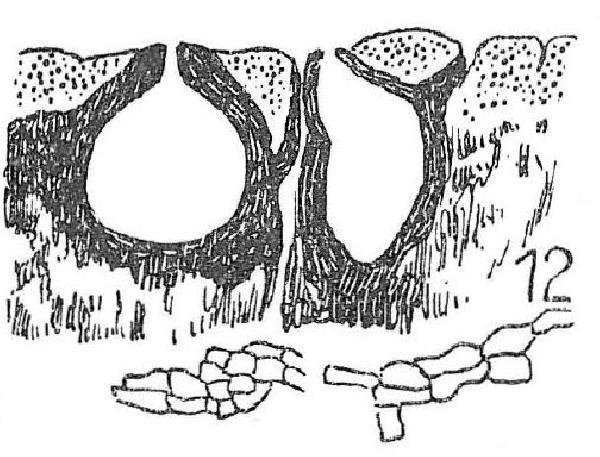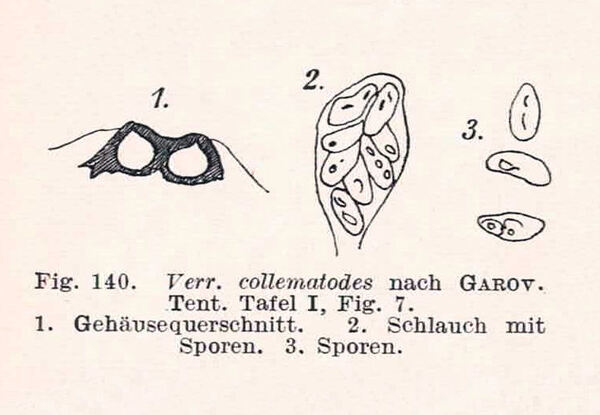Verrucaria collematodes Garov.
Tentam. Dispos. Lich. Langob.: 31, 1865.
Synonyms:
Distribution: N - Ven, Lomb, Emil (Fariselli & al. 2020), Lig. C - Tosc, Sar (Nascimbene & al. 2023). S - Camp.
Description: Thallus crustose, episubstratic, subgelatinous when wet, cracked-areolate, well-delimited, brown-black to black when dry, dark brownish green when wet, epruinose, the areoles smooth, flat to convex, not blastidiate at margin. Cortex paraplectenchymatous; algal cells arranged in more or less vertical columns; medulla with a well developed, carbonaceous black basal layer. Perithecia black, 0.5-0.7 mm across, entirely immersed or slightly projecting, often laterally covered by thallus. Involucrellum adpressed to exciple, extending to the lowest part of the perithecium and merging with the black basal layer; exciple subglobose, 0.2-0.35 mm across, the wall dark brown; hamathecium of periphyses and periphysoids, interascal filaments absent; hymenial gel hemiamyloid, I+ red (I+ blue at very low concentrations of I), K/I+ blue. Asci 8-spored, clavate, I-, fissitunicate, the wall thickened above, with an ocular chamber, dehiscent by extrusion of an endotunica to form a delicate rostrum, Verrucaria-type. Ascospores 1-celled, hyaline, ellipsoid, 18-27 x 8-10 µm. Photobiont chlorococcoid. Spot tests: K-, C-, KC-, P-, UV-. Chemistry: without lichen substances.
Note: mostly on calciferous or base-rich siliceous substrata, including roofing tiles, walls and mortar; on the whole a rather poorly known taxon of the V. nigrescens-complex, reported from different countries in Central and Southern Europe.
Growth form: Crustose
Substrata: rocks
Photobiont: green algae other than Trentepohlia
Reproductive strategy: mainly sexual
Pioneer species
Poorly known taxon in need of further study
Commonnes-rarity: (info)
Alpine belt: absent
Subalpine belt: absent
Oromediterranean belt: absent
Montane belt: rare
Submediterranean belt: rather rare
Padanian area: very rare
Humid submediterranean belt: very rare
Humid mediterranean belt: very rare
Dry mediterranean belt: very rare

Predictive model

Source: Servit, M 1949: Nove nebo mene zname druhy lisejnikove celedi Verrucariaceae. Species Verrucariacearum (Lichenes) novae vel minus cognitae. - Sbornik Narodniho Musea v Praze 5(9): 1-51. Tab.1 - Public Domain
Growth form: Crustose
Substrata: rocks
Photobiont: green algae other than Trentepohlia
Reproductive strategy: mainly sexual
Pioneer species
Poorly known taxon in need of further study
Commonnes-rarity: (info)
Alpine belt: absent
Subalpine belt: absent
Oromediterranean belt: absent
Montane belt: rare
Submediterranean belt: rather rare
Padanian area: very rare
Humid submediterranean belt: very rare
Humid mediterranean belt: very rare
Dry mediterranean belt: very rare

Predictive model

 INDEX FUNGORUM
INDEX FUNGORUM
 GBIF
GBIF
 DOLICHENS
DOLICHENS



